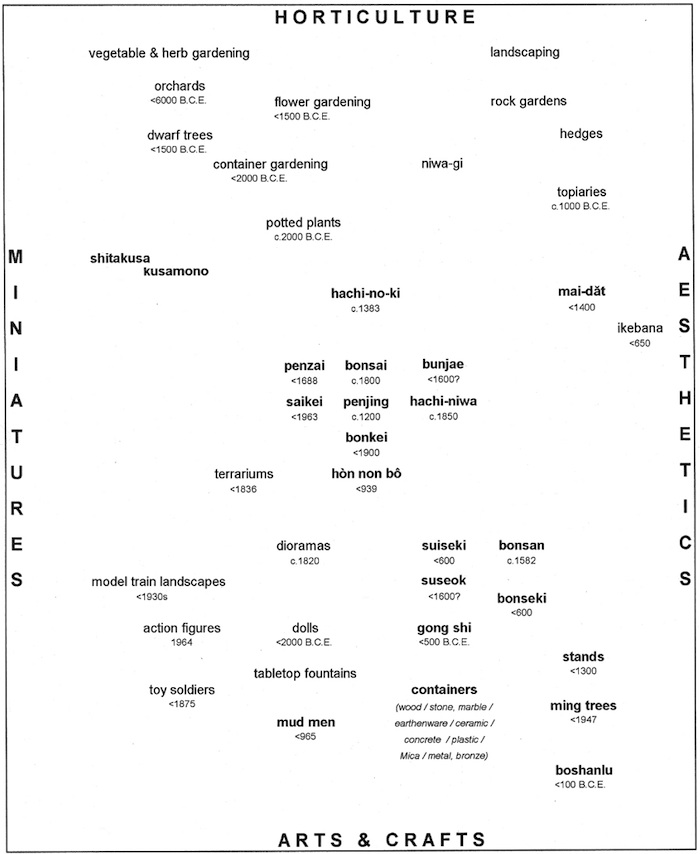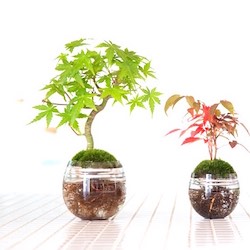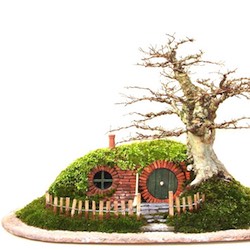"Bonsai" is a term for the Japanese art of designing dwarfed trees in shallow containers. "Penjing" is the older Chinese form that often has wilder-looking trees and landscapes in pots. These two are the most common forms of what we call magical miniature landscapes, a group of arts that are philosophically-related. When examined closely, this particular group of creations can also be seen as related to some other human endeavors.
There are at least four areas of human experience ultimately employed in the creation and experiencing of the various magical miniature landscapes: Horticulture, Aesthetics, Miniatures, and Arts & Crafts. The accompanying schematic plots the suggested relations between these arts (and a few other creations) and these four areas. An approximate date is given for the earliest known representative of most of these creations. We acknowledge that not every last type of these landscapes is shown here.
Now, of course, it is not necessary to be aware of this synergy – or even the history of Bonsai and related art forms in order to successfully create and experience these compositions. Indeed, the vast majority of artists and viewers who have, who do, and who ever will design or see a Bonsai and its cousins do not know these things. This author does believe, however, that awareness of the larger scope of these magical miniature landscapes can be used as mental source material for a wider range of compositions and for a deeper appreciation of what we all are making and/or viewing.
The synergy of magical miniature landscapes

Glossary
bonkei -- Japanese miniature landscape made with real or artificial plants and rocks in a shallow container.
Bonsai – dwarfed, shallow-potted, perennial woody plant <1.2 m (48”) tall; aka artistic pot plant or table culture plant or living ming tree; originally only referred to the Japanese version, but now used to describe generally any artistically-designed dwarfed potted tree.
bonsan – Japanese miniature landscape made with sand, rock and sometimes vegetation.
bonseki – delicate Japanese miniature landscape flat or three-dimensional made with small stones and white sand on a black lacquer tray; sometimes very small figurines are added for scale or theme.
boshanlu -- ancient Chinese incense burner, generally 4-13” (10-33cm) tall, usually made of metal(s) and sometimes resting on a small dish, with perforated dome lid that is in the form of the sacred mountains.
bunjae – Korean dwarfed potted trees.
Bonsai pottery -- generally shallow, complementary-shaped holders for miniature landscapes usually with at least one bottom drainage hole; those preferred for Japanese styles tend to be plainer, earth- toned, and subtle, while Chinese-styled models are often more colorful and expressive.
gong shi -- Chinese scholar's stone, usually portable, soft to hard, light to dark, interesting-shaped and dynamic with rough texture, especially prized if with holes and cavities throughout, most times its bottom is cut to fit on a custom-carved wooden base (not always low-profile) or in a water- filled basin.
hachi-niwa -- Japanese miniature or dish garden 6-24” (15-61cm) wide with moss, sand, pebbles, plants, and dwarfed trees.
hachi-no-ki – an older style Japanese dwarfed potted tree of 48” (1.2m) tall in a deeper pot and not as formally-shaped as bonsai.
hòn non bô -- Vietnamese miniature landscapes 1' to 25' (0.3-7.6m) high, made with rocks, plants and water imitating island scenery, mountains and surroundings, often with accompanying verses, incense, figurines, etc.
Ikebana – Japanese minimalist, disciplined arrangement in a complementary container made with various fresh and/or withered plant materials and emphasizing shape, line and form to symbolize relation of heaven, earth and humans; a distant philosophical cousin of bonsai.
Kusamono – Japanese-style living plant material such as seedling-type trees, flowers and grasses presented as tall, mixed plantings or all the same plant in or out of a container and usually displayed on a mat, flat board, or flat ceramic tray; this is the main focus of an exhibit indicating place or season and can be complemented by a secondary scroll, figurine or Suiseki to complete the picture.
mai-dăt -- certain Thai dwarfed trees in pots or in the ground that are highly-stylized, often with very twisted angular branches and an odd number of pom-pom clumps of foliage, abstractly-shaped to be symbolic of various concepts.
ming tree -- dwarf potted tree sculpted out of artificial/dead materials (wire, plastic, glass, stone, etc.).
mud men -- small earthenware figurines of people, boats or pavilions, for example, which can be added to miniature landscapes for scale or theme.
niwa-gi – an artistically-trained tree, not in a pot but planted in a garden.
Penjing -- Chinese landscape in a container (some of stationary concrete up to 2.1 m (84”) long) made with living miniature trees that are less formally-shaped than Bonsai and sometimes also with rocks and/or water suggesting cliffs and sea; these compositions are often designed in distinct regional styles.
penzai -- Chinese single-specimen trees (some up to 3 m (120”) tall) growing in wooden trays or earthenware pots.
saikei – Japanese miniature living landscape made with rocks, small plants, and underdeveloped trees.
shitakusa – Japanese-style living plant material in a plain unobtrusive container which is smaller than and completes the exhibit of a Bonsai. a Suiseki and or a scroll by indicating a theme season or location, for instance; also called accent plant, companion planting or complementary plant.
Stand -- from simple planks or bamboo mats to carved furniture pieces or large lacquered natural roots, used to support or elevate miniature landscapes for display.
Suiseki -- Japanese viewing stone (lit. “water stone”), small and portable, hard, dark sometimes with inclusions, smooth-textured, subtle, quiet, with minimal alterations to fit on usually flatter custom-carved wooden base or in a sand and/or water-filled tray.
suseok – Korean viewing stone, usually portable and dark, never cut to flatten bottom for custom- carved wooden base.
topiary – usually ground-planted specimens of compact-growing evergreen trees or shrubs sculpted into animal, geometric, or highly-stylized shapes, sometimes over an internal wire armature.
Some thoughts
Horticulture
“Horticulture may be described as the process of growing plants in a relatively intense manner. This contrasts with agriculture, which... [can rely] on a high level of machinery used over an extensive area of land... Horticulture often involves the manipulation of plant material, e.g., by propagation, by changing the above-ground environment, or by changing the root environment. There is a fundamental difference between production horticulture, whether producing plants themselves or plant products, and service horticulture, i.e., the development and upkeep of gardens and landscape for their amenity, cultural and recreational values. Increasingly, horticulture can be seen to be involved with social well-being and welfare through the impact of plants for human physical and mental health...”
“There is a feature common to all the aspects of horticulture: the grower or gardener benefits from knowing about the factors that may increase or decrease the plant's growth and development.”
(Adams, Charles R. and Michael P. Early Principles of horticulture; Oxford: Elsevier Butterworth-Heinemann; 2004, pp. 1,2)
Aesthetics
“...to reduce the amount of vegetative growth that cannot be supported by the loss of root mass following transplanting. This is also the principle behind the cultural practices of the Bonsai in containers and pollarding in some European cities to offset low soil volume in confined urban settings.”
“There are some times when aesthetics is the primary reason for pruning. Pruning can be done to remove branches to expose ornamental features of the bark or the shape of the tree trunk. Pruning limbs to expose or enhance vistas is sometimes done and also can be done to train a young tree into a desired form. Techniques such as pollarding, espalier, topiary, hedge work, and Bonsai are frequently done for aesthetic reasons.”
(Kuser, John E. Handbook of urban and community forestry in the northeast; New York: Springer, 2000; pp. 197, 207)
Miniatures
“...Miniatures are small things that do not seek accuracy in representation, that are not precise or exact. Furthermore, miniatures result from human experimentation with the physical world; they are cultural creations. In this sense there are no naturally occurring miniatures; each one is a person's utilization of eye and hand to manipulate the world...
[Dwarfed trees in the wild are non-human natural; those same trees collected and put in pots become Bonsai or bonsai-in-training, a human creation - RJB.]
“bonsai... is a replacement of the complexity of the life-size tree with the simplicity of convention. Bonsai compresses information and detail about the texture of the bark, the subtleties of color, and the structure of fine branches...”
“Scholars' rocks... provide a physical stimulus, a tangible but imaginary vehicle for travel through an imagined landscape. The rock sitting on a scholar's desk both provides a concrete reality and suggests places that belong to the other worlds of established mythologies. Scholars' rocks work because they possess the capacity to suggest imaginary retreats; while some detail stimulates memory, the specific details, of cloud and water for example, are left to the viewer's imagination...
“In representing trees, rocks and landscapes, the artists creating Bonsai. scholars' rocks and Penjing manipulate scale to transform the real world into separate, intimate alternatives. They create images of reality that flip back and forth between the natural and cultural worlds... [and in this way] transform viewers' ways of seeing and thinking.”
“Miniature manipulation of reality works from two processes: abstraction and compression. [This] reduction of size [also] reduces details. The resulting, intentional, understatement provides much of the power of a miniature because [the process] demands selection... The brevity that comes with abstract representation forces the viewer beyond the information that is provided. The abstraction of a miniature demands that a spectator draws inferences ...to think of what is not there, of what has been left out. Where are the other trees? Where are the little birds that should surround the bonsai? Where is the rest of the mountain that is invoked by the scholars' rock?
“Through abstraction, a miniature is an object made active; it forces the viewers to do something that otherwise they would not do... Critically, the range of inferences that any one viewer can draw are almost limitless; constraints depend only on each viewers' beliefs, understandings, interests, backgrounds and desires...
“Compression further contributes to the distancing of miniaturization from factual modeling... Miniaturization concentrates and distills what is normal in peoples' routine day-to-day activities and thoughts and then produces a deeper expression of a part of that reality.
“...By reducing the world-at-large's reality, a miniature provides a way of making sense of that world... By providing the better understanding and physical control over a thing, miniaturism suggests security and thus brings pleasure. By creating a world in which the human scale matters most and dictates all spatial relationships, miniaturism reassures and liberates the viewer. In so doing and in making the viewer powerful and all-knowing, a miniature object makes the viewer free to indulge in flights of fantasy.”
“..[T]hree-dimensional representations allow complete comprehension. They give the spectator the highest degree of authority to change their position of viewing and thus of understanding; every side can be seen, nothing is left to the imagination, nothing is hidden or left out.
“On the other hand, and this is the paradox, in moving around the sculpture or turning over the figurine in one's hand, the spectator (or the handler) never holds the entire view at any one time... In this sense, three-dimensional objects escape complete comprehension. They can never, simultaneously, be viewed in their entirety.”
(Bailey, Douglass Whitfield Prehistoric figurines; Oxford: Routledge, 2005; pp. 29, 30, 32-33)
Arts & Crafts
“Bonsai (and Suiseki) thus isn't simply nature as it is; it is nature in a super concentrated form, a form that is squeezed, compacted, and multiplied in intensity. In the case of Bonsai. and ikebana and other crafts, we can think of Japanese art as nature reinterpreted and intensified, a distillation of its essential quality.
“Thus, the painstaking pruning and wiring of Bonsai are not meant to reproduce nature as it is but to produce something beyond what is usually found in nature: simply to copy nature pales in comparison. It is when the life force and creativity of the artist – the human being as a functioning part of nature – merge with the essence and rhythm of nature that something wondrous results. The result is art – not Japanese art – but art...”
“The idea of asymmetry is one example. Just as flowers do not grow in neat rows in the wilderness, symmetry is avoided in a Japanese garden or in ikebana. Nature is 'arranged' in the traditional Japanese arts, but the arrangement accords with the intrinsic movement of ki in nature. Thus, in general an ikebana artist will bend a flower, but not so much that it will be forced into a shape that it would not exhibit in nature...”
“In Bonsai. Suiseki, and the arrangement of a traditional garden, Japanese art aims to capture the essential nature of tree, stone, landscape, to create a work of art that exemplifies the very core of these things, and ultimately, the substance of nature itself. This aim begins with the recognition of the fundamental character of the thing the artist is working with and progresses to a 'sculpting' of the material to intensify the expression of its intrinsic character. A Japanese gardener works 'with the grain,' and as he prunes and shapes, he reveals an aspect of beauty that is born in nature but that nature has hidden in its abundance.
“Japanese art aims to discern and then liberate what has always been present. And who are we to assume that such liberation is needed? Humanity is a part of nature. We, like the flowers in ikebana and the trees and shrubs in the niwa [garden], are part of the infinite variety that is the universe. We are transitory and timeless, existing in the eternal present, just like the aspects of nature we create with. In perceiving and freeing aspects of nature that have always existed, we ultimately see into our own nature.
“In Japan native arts both humble and dignify their participants. Humankind is forced to recognize its mortality and the fact of impermanence. But in seeing our smallness in the universe, we discover our link to something infinitely large, eternal, and awesome.”
(Davey, H. E. Living the Japanese Arts & Ways: 45 Paths to Meditation & Beauty; Berkeley, CA: Stone Bridge Press, LLC; 2003, pp. 62-63, 83-84)
And it is a form of the wood-working craft we do when we create, carve, and shape deadwood branches (jin), strips of deadwood on trunks (shari), or “simply” bend trunks or branches with wire, weights, twisting, or heating.
As hinted in the chart, the stands and containers used to display and hold our compositions also involve levels of creativity.
These are just a few representative thoughts about these four aspects which come together in our interests. What are other quotes or thoughts relevant to the further understanding of magical miniature landscapes? And if this x,y chart were made three-dimensional, would the z-axis include such characteristics as duration, age, or amount of experience?
The principal sources of information for the above terms are you://www.phoenixbonsai.com/Terms.html; Phan Van Lit with Lew Buller Mountains in the Sea (Portland, OR: Timber Press; 2001); and Kora Dalager, “Shitakusa versus Kusamono,” http://www.snowcrest.net/windowboxnursery/articles/kora.htm, among others.
Written by: Robert J. Baran. "Getting serious about Bonsai in early 1986, I then wanted to learn more about its history and origins. Finding very little information in the first books I was reading at the time, I wrote down the, literally, one or two sentence histories per book which I came across in order to put together "a little history." ".




